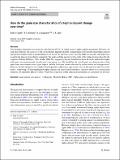Files in this item
How do the grain size characteristics of a tephra deposit change over time?
Item metadata
| dc.contributor.author | Cutler, Nick | |
| dc.contributor.author | Streeter, Richard T. | |
| dc.contributor.author | Dugmore, Andrew | |
| dc.contributor.author | Sear, E.R. | |
| dc.date.accessioned | 2021-06-21T08:30:02Z | |
| dc.date.available | 2021-06-21T08:30:02Z | |
| dc.date.issued | 2021-06-12 | |
| dc.identifier | 263136399 | |
| dc.identifier | dba0f3d2-8b73-4a8d-bbf9-8f480116c982 | |
| dc.identifier | 000660792700001 | |
| dc.identifier | 85107765446 | |
| dc.identifier.citation | Cutler , N , Streeter , R T , Dugmore , A & Sear , E R 2021 , ' How do the grain size characteristics of a tephra deposit change over time? ' , Bulletin of Volcanology , vol. 83 , no. 7 , 45 . https://doi.org/10.1007/s00445-021-01469-w | en |
| dc.identifier.issn | 0258-8900 | |
| dc.identifier.other | ORCID: /0000-0003-2261-4540/work/95772557 | |
| dc.identifier.uri | https://hdl.handle.net/10023/23394 | |
| dc.description | Financial support was provided by the National Science Foundation of America through grant 1202692 ‘Comparative Island Ecodynamics in the North Atlantic’ and grant 1249313 ‘Tephra layers and early warning signals for critical transitions’ (both to AJD). | en |
| dc.description.abstract | Volcanologists frequently use grain size distributions (GSDs) in tephra layers to infer eruption parameters. However, for long-past eruptions, the accuracy of the reconstruction depends upon the correspondence between the initial tephra deposit and preserved tephra layer on which inferences are based. We ask: how closely does the GSD of a decades-old tephra layer resemble the deposit from which it originated? We addressed this question with a study of the tephra layer produced by the eruption of Mount St Helens, USA, in May 1980. We compared grain size distributions from the fresh, undisturbed tephra with grain size measurements from the surviving tephra layer. We found that the overall grain size characteristics of the tephra layer were similar to the original deposit, and that distinctive features identified by earlier authors had been preserved. However, detailed analysis of our samples showed qualitative differences, specifically a loss of fine material (which we attributed to ‘winnowing’). Understanding how tephra deposits are transformed over time is critical to efforts to reconstruct past eruptions, but inherently difficult to study. We propose long-term, tephra application experiments as a potential way forward. | |
| dc.format.extent | 7 | |
| dc.format.extent | 916910 | |
| dc.language.iso | eng | |
| dc.relation.ispartof | Bulletin of Volcanology | en |
| dc.subject | Laser particle size analysis | en |
| dc.subject | Taphonomy | en |
| dc.subject | Mount St Helens 1980 | en |
| dc.subject | Tephra grain size distributions | en |
| dc.subject | GB Physical geography | en |
| dc.subject | NDAS | en |
| dc.subject.lcc | GB | en |
| dc.title | How do the grain size characteristics of a tephra deposit change over time? | en |
| dc.type | Journal article | en |
| dc.contributor.institution | University of St Andrews. Bell-Edwards Geographic Data Institute | en |
| dc.contributor.institution | University of St Andrews. School of Geography & Sustainable Development | en |
| dc.identifier.doi | 10.1007/s00445-021-01469-w | |
| dc.description.status | Peer reviewed | en |
| dc.identifier.url | https://link.springer.com/article/10.1007%2Fs00445-021-01469-w#Sec6 | en |
This item appears in the following Collection(s)
Items in the St Andrews Research Repository are protected by copyright, with all rights reserved, unless otherwise indicated.

